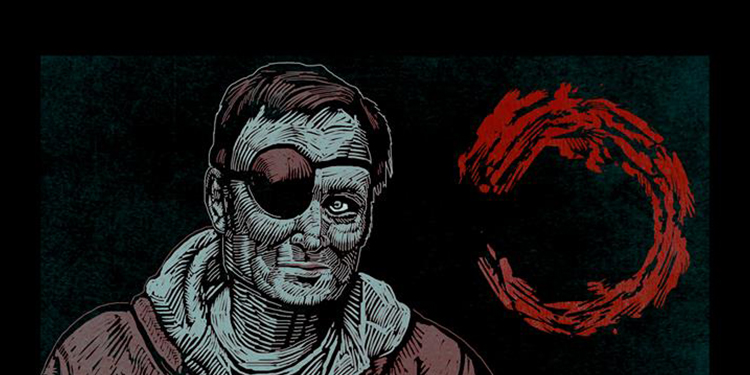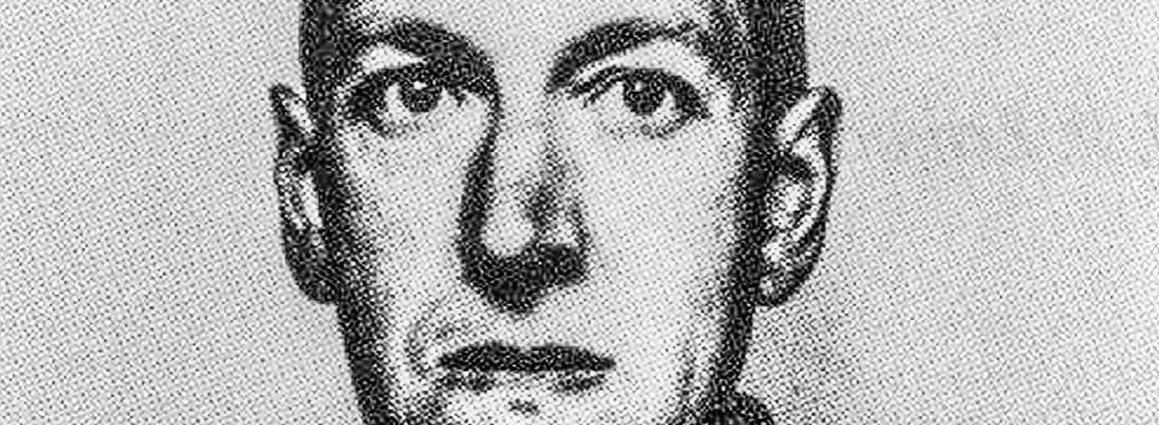I first ran across Yves Tourigny’s work through Facebook, where I follow a lot of weird-lit/horror authors. I began to notice that a number of authors were posting illustrations or alternative covers (in a couple cases, even postcards inspired by their work) done by the same artist. The style was obviously digital (drawn on a tablet) but had the outward appearance of old woodcuts. It struck me as such a cool blending of modern technology and old-world style that I wanted to know more. I learned that the artist not only did illustrations, but also designed and illustrated table-top games (many set in the fictional worlds of these authors). I hadn’t ever considered card and board games much (other than a five-year obsession with Settlers of Catan), but these looked great, and the horror element and obvious appreciation and respect for source material fascinated me. I wanted to know more so I reached out to Yves and sent him some questions about what he does, and he was kind enough to take the time to shed more light into his world.
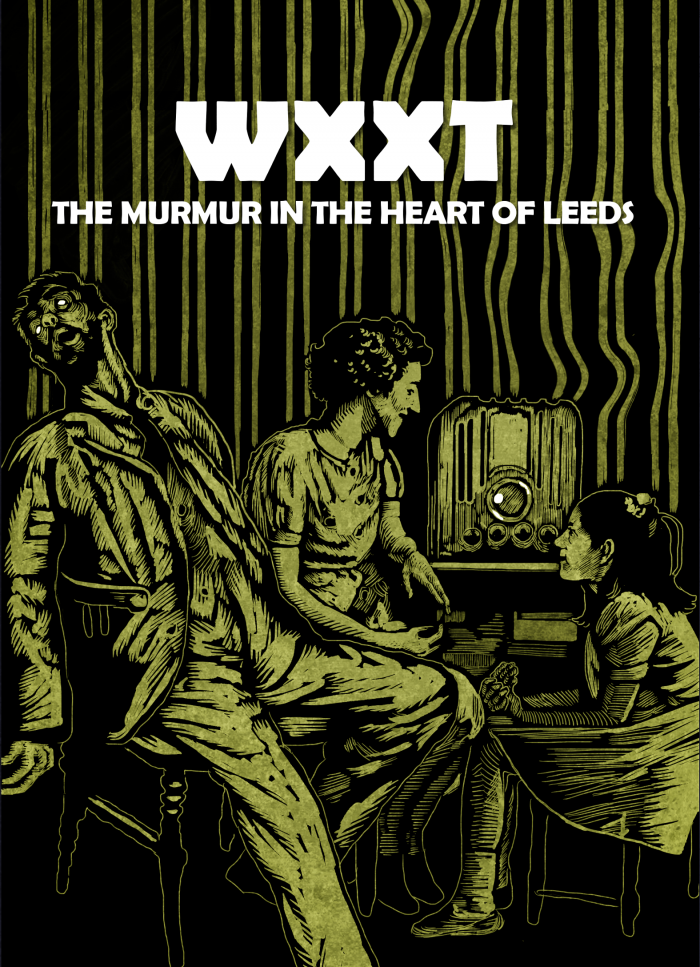
Postcard inspired by Matthew Bartlett’s writing
Tell us about how you got into art in the first place.
I’ve been into art for as long as I can remember, as an appreciator if not a creator. The inclination to create has always been present, and I’ve sketched and doodled for much of my life, but it was when I started designing board games that my skills were able to develop.
Can you explain what you do for readers unfamiliar with your work?
That’s a difficult one. I think of myself mainly as a game designer. Illustration and graphic design are for me auxiliary skills that I’ve developed through practice in the process of putting together game prototypes. That said, I’ve in the past year been saddled with the label of illustrator or artist, and while I’m not entirely comfortable with it, I’m beginning to accept it. What I _do_ is produce stuff, for myself and others, as a way to connect with people.
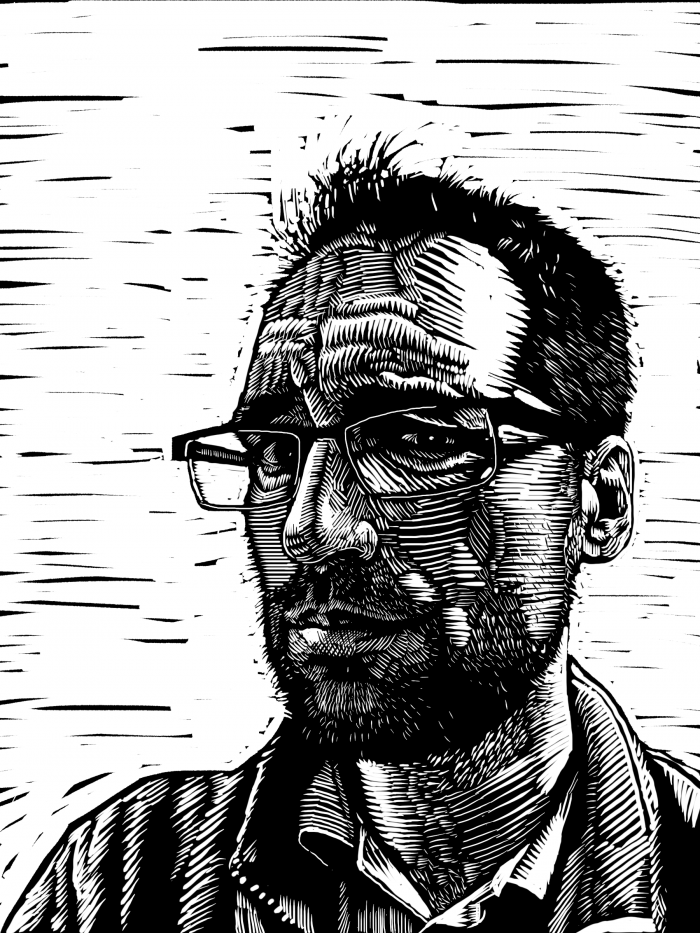
Artist self-portrait
What projects have you published?
I have not really published any projects myself, except a few postcards and posters. Other people have published my work, however. Games that I’ve designed include ‘Blueprints’, which was published by Z-Man Games in 2013, and ‘Expedition: Northwest Passage’, also published in 2013 by Matagot. Illustrations of mine have appeared in Selena Chambers’ ‘Wandering Spirits’, the latest edition of Matthew Bartlett’s ‘Dead Air’, and the Czech edition of Laird Barron’s ‘Occultation and Other Stories’. More projects are in the pipeline, including four more board games (two of which are illustrated by me), and more book illustrations.
Do you make a living off game design/illustration, or do you have a “day job”?
I don’t make a living from either. I have a full-time day job as a public servant. The two jobbies serve as a secondary source of income – really, I’d be surprised if they covered much more than the costs of engaging in them. I do them because they provide creative and social outlets, and a chance to practice skills that I want to develop and enjoy practicing.
Do you work “for” someone, freelance, or get contracted?
Yes to all those. I primarily work for myself, in the sense that most of what I do is not monetized – either because I fail to find a buyer, or because I do it mainly to amuse myself and others. I get approached for illustration work, which is contracted.
What is the balance of illustration vs. game design in your work load? Is one more lucrative than the other?
It varies dramatically from day to day, depending on the project(s) with which I’m currently engaged. I seem to be doing more illustration work these days.
The game design work has been more lucrative, but I’ve also been at it longer, and the royalties from the games that were published in recent years have diminished since the games are now out of print. I’ve made more money from illustration work in the past year than games. It’s hard to say going forward which will be more lucrative.
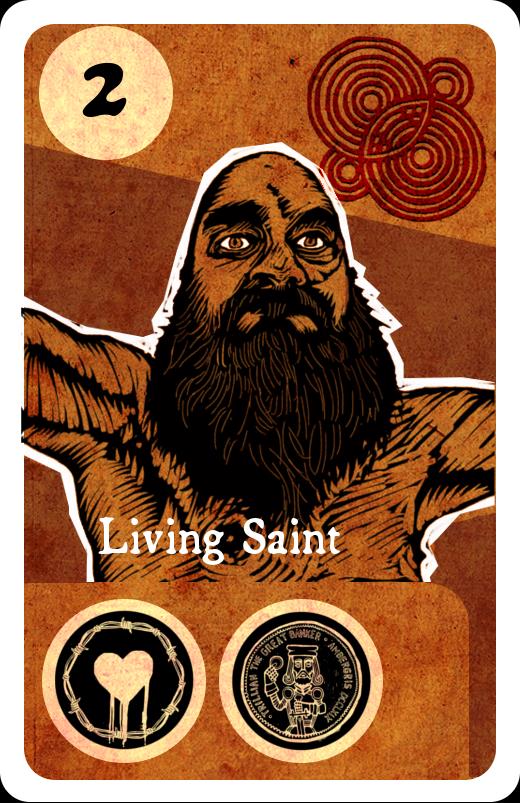
You seem to work a lot with the Weird Lit crowd; how did that come about? Have you always been into horror?
Reading has always been very important to me, and Lovecraft was my gateway into horror. His materialist, cosmic horror appealed to my sensibilities from adolescence onward (his racism far less so). I started reading a lot of the Cthulhu Mythos fiction that had been and was being produced in the 1990s, and quickly discovered that most of it was subpar. I turned to older writers and found much I liked in Lord Dunsany, Clark Ashton Smith, Robert Chambers, but couldn’t find any contemporary authors that spoke to me – Stephen King and Clive Barker left me mostly cold. I turned away from weird fiction, and read mainly non-fiction books for 15-20 years, getting my fiction fix from graphic novels.
Working on a Lovecraft-themed game 18 months ago (the probably-soon-to-be-published Arkham Noir) I picked up a used copy of Ross Lockhart’s The Book of Cthulhu to see what had changed in the years I’d been away. A lot of the stories in that book were of a far greater quality than I was expecting. The Laird Barron story in particular stuck with me. I ordered the second volume, and once again the Barron story hit me like a speeding truck. I ordered and devoured the three collections and two novels that were available at the time. Here was an author who was writing just about exactly what I wanted to read, and whose sensibilities were clearly aligned with my own (despite my being a sheltered Canadian urbanite).
Using Barron as a barometer of quality, I explored the new weird fiction scene principally by following his recommendations. I have not been disappointed often in that process. That’s how I discovered the Weird Lit crowd. How they discovered me was through my charitable works.
Barron’s work, as I hinted, is deeply meaningful to me, so I wanted to spread the word and make sure that I wasn’t missing any of it. His author website was a bit of a mess, there was no central list of all his stories, not to mention conflicting, out-of-date, and/or false information about where they were published. For my own sanity, and as a service to others, I sat down and compiled a complete bibliography. I also compiled a list of interviews, reviews, critical works, etc., all of which can be found on theywhodwellinthecracks.com. Finally, I started working through the stories and annotating them – a slow and ongoing process.
In parallel, I was working on the aforementioned Arkham Noir, a solo card game based on Lovecraft’s stories. Rather than the general approach taken with a great deal of Cthulhu-themed games, where as many references and monsters are packed into them as possible, with little regard for the appropriateness of such an approach, I wanted to dig deep and focus on the elements that made the stories work. Each “case” in the game is based on a close reading of a few stories which share certain elements – Arkham, the witch-cult, and Meadow Hill in the case of “The Dreams in the Witch House”, “The Thing on the Doorstep”, and “The Unnamable”, for example.
When I discovered Barron’s work, I was in the process of looking for other “Cthulhu Mythos” authors whose work might be suitable for adaptation in the Arkham Noir framework. His stories, with their entirely independent mythos, couldn’t be more perfectly suited, so I set about creating a case out of a few of them, as a proof of concept. Since each set consists of 60-some illustrated cards, all of them essentially “fan art” which I frequently posted online, it gave me some currency in the Weird Lit community. I’m not sure if there will ever be a Laird Barron set, but I was able to work on one inspired by Matthew M. Bartlett’s WXXT stories.
Long-story-short, authors seem to like it when someone who groks their work produces fan art with some degree of talent. Responding as I do to positive reinforcement, it’s not surprising that I’ve produced illustrations for other authors that are meaningful to me.
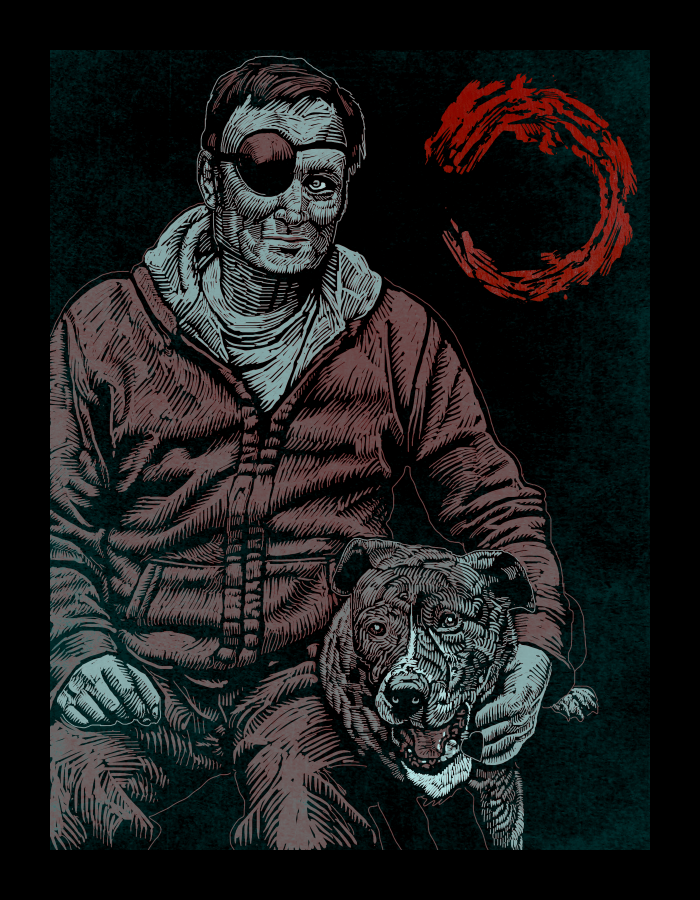
Portrait of horror-writer Laird Barron
What is your process/what technology do you use for your illustration and design?
I use an iPad Air 2 using an Adonit Jot Pro stylus and Sketchbook Pro application for most of my illustration work. I do very little traditional methods besides sketching. I use a laptop with Inkscape software for vector illustrations (such as icons) and GiMP for digital manipulation of images. I do produce some works with linocut/woodcut methods, but prefer simulating the process digitally, for reasons of cost and time.
I’m not an accomplished artist – I was press-ganged into it by the need for illustrations for my game projects. I work quickly, partly as a response to having to produce large quantities of images, partly because my work involves a lot of trial and error, and partly because “good enough” is good enough for game prototypes. I’m still getting used to the idea that the illustrations that I consider to be placeholders until real artists step in and produce the finished art, are considered suitable or “good” by others.
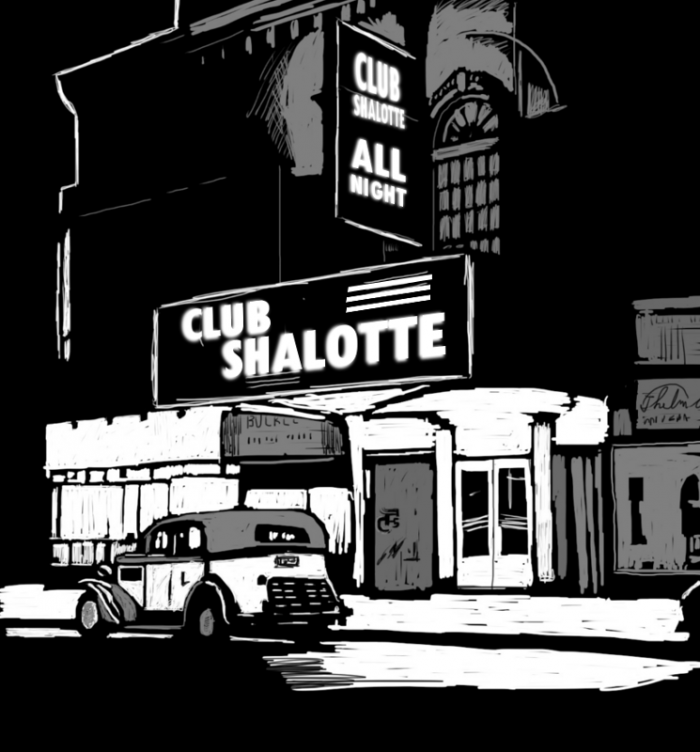
Clue Illustration
What is your process for bringing a game from idea to finished product?
It’s a long process, but it boils down to iteration. Make the game, test it, make changes that will (hopefully) improve it, and repeat until you have something worthy of publication, or until you give up on the project. Once I am there (or think I am), I present the game to publishers, and that’s a whole other process. If the game get a licensing agreement with a publisher, the game is in their hands, and they are responsible for the production of the final product, including hiring artists to illustrate it. ‘Arkham Noir’ is the first game where I was hired to produce the illustrations in addition to designing the game, although another publisher licensed another game of mine at roughly the same time, and has hired me to illustrate it as well. That’s not usually part of my process, but I’m happy to try it.
Could you walk us through a typical work day?
My typical work day involves 9 hours of day-job and commute, then several hours of game design and illustration work. Game design and illustration work gets done on the week-end also. I don’t watch television, but I do read, as that fuels my game design and illustration work.
You have crowd-sourced photos from friends and fans for your illustrations; how did that come about and do you see yourself doing it more?
Here’s a secret: people love looking at themselves. Our image lights up the pleasure centers of our brain, for the most part. Crowd-sourcing photos for illustrations for prototypes has a few distinct advantages: it saves me from having to search for suitable photos, which seems like laziness on my part, but when a game involves 50 different characters, it adds up; it provides me social capital, since the people who volunteer derive some happiness from participating and from the resulting illustration, and will often feel invested in that and in my other projects; finally, it provides me with an opportunity to practice, and an audience to please.
Could you walk us through a specific [horror] game’s plot and mechanics?
Arkham Noir is a solo investigation game, basically you against the deck of cards. All the cards are clues, or leads, and fall into six categories: locations, threats, people, artifacts, monsters, and evidence. There are investigation icons on the right and left edges of the cards: one on the left and two on the right, typically. The game involves chaining these cards together into lines of investigation by matching the investigation icons, in order to close cases and score special clue cards with puzzle icons. Those puzzle cards help you understand the big picture, and scoring five of them before you run out of time or stability is the goal of the game.
It’s structured like an investigation, like a puzzle to solve, because that’s how Lovecraft’s stories are frequently structured. I think that Lovecraftian games where you fight monsters are almost entirely missing the point. My hope is that the game has some literary merit as well: the game aims to increase your appreciation for the stories, by highlighting the elements which make it work, and the elements, thematic and otherwise, which they have in common. Likewise, familiarity with the stories should increase your appreciation for the game, but it should not be necessary.
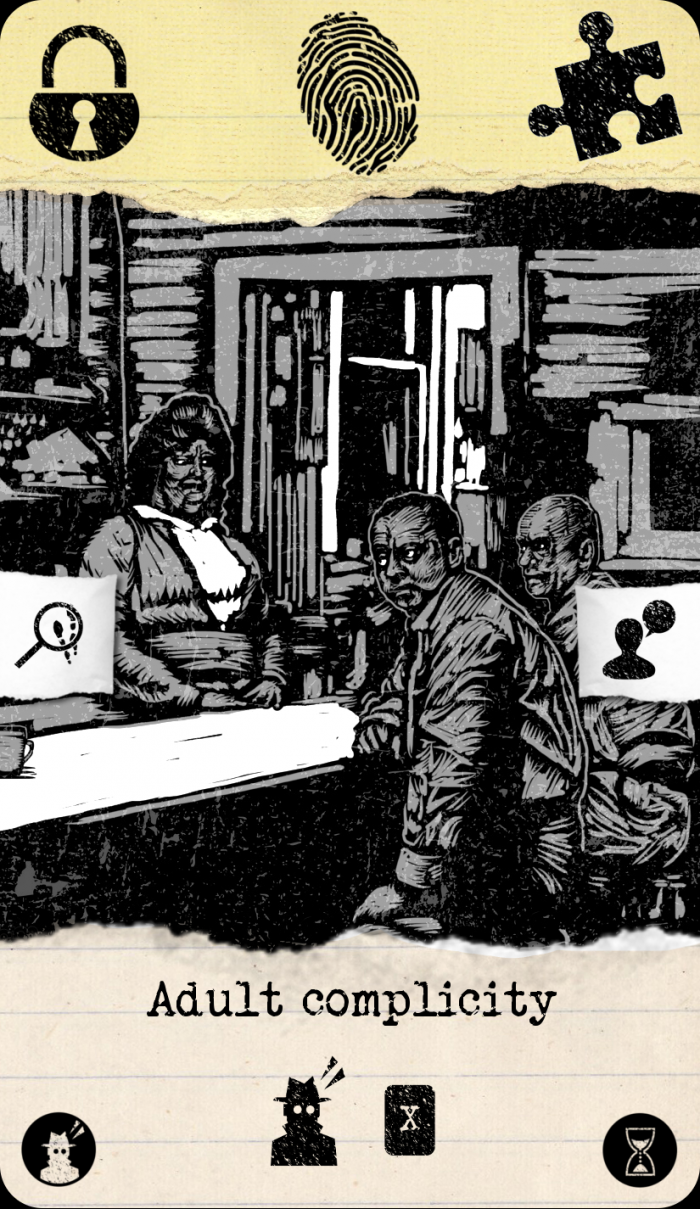
Game Card
How does one get into game designing?
The same way one gets into writing, or painting, or any other art form. You sit down and start doing it, ideally after having absorbed some of the basic lessons of other designers by playing contemporary games. Nobody needs another roll-and-move, Monopoly-clone, or card-based trivia game.
Where can we buy your games?
Game stores, brick-and-mortar or online. There are still copies of my earlier games out there, and they are well worth getting. The timelines are still fuzzy, but there should be four games with my name on them coming out within the next two years, if all goes well, including Arkham Noir.
Last Question: What are some challenges you face?
I’m a mortal, conscious being in a vast uncaring universe, or did you mean something less existential? It’s challenging working a full-time day job and finding time for family, rest, and reading, let alone illustration and game design. I’m not sufficiently entrepreneurial or self-confident to contemplate doing those things full-time, so I wait patiently for retirement and keep on trucking.
Thank you so much for the time, Yves! We really appreciate it.
Yves and more examples of his work can be found on facebook and his website
https://www.facebook.com/yves.tourigny

